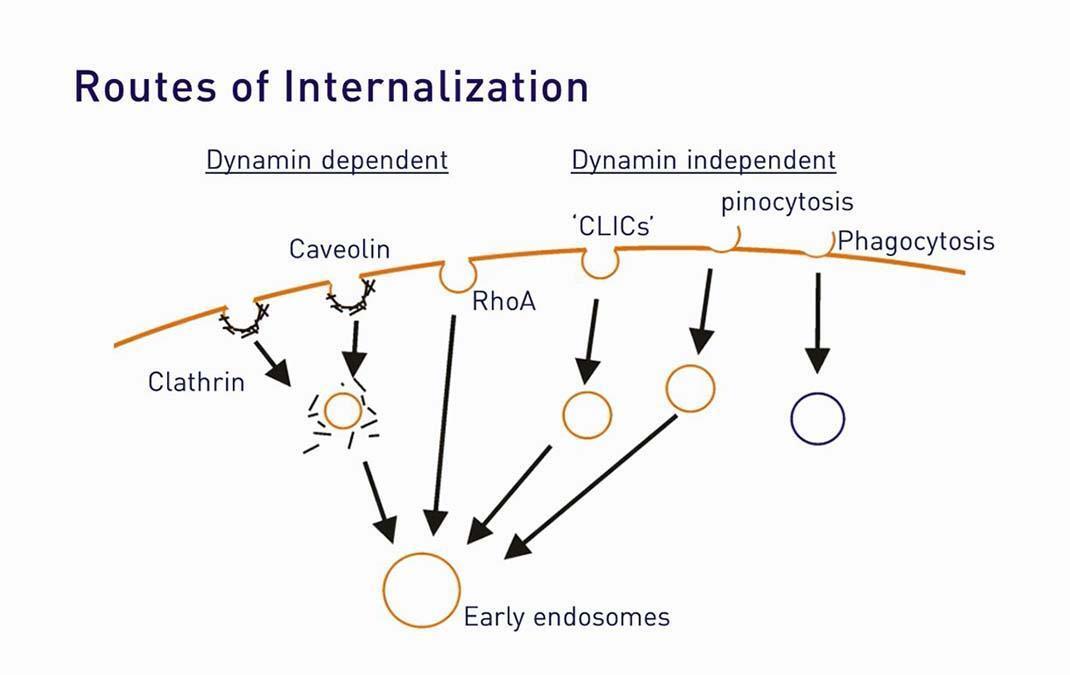Search Thermo Fisher Scientific
Endocytosis and Phagocytosis Information

Endocytosis and phagocytosis play an important role in cell metabolism and function. Here you will find resources to help you understand how you can track and monitor these processes.
Endocytosis and phagocytosis features
On-demand webinar
The meaning of life at the cellular level: Visualizing membrane trafficking
This webinar provides an overview of the processes involved in membrane trafficking, along with strategies to investigate them using fluorescence microscopy.
Scientific poster

Correlating internalization and potency to accelerate antibody discovery and development
In this scientific poster presented at a Keystone Symposium, we present experimental data demonstrating the use of pH-sensitive fluorophores to monitor the three primary mechanisms of endocytosis in live cells.
Endocytosis and phagocytosis learning resources
No records were found matching your criteria
| Type | Title | Categories |
|---|---|---|
| Application note (2015) | Guide to setting up hypoxic conditions on the EVOS FL Auto Imaging System with Onstage Incubator | EVOS FL Auto Microscope, fluorescence microscopy/fluorescence imaging, live-cell imaging, onstage incubator, phagocytosis |
| Application note (2015) | Quantitation of proliferating cells with the EVOS FL Auto Imaging System | antibodies, antibody labeling, ArrayScan, cell proliferation, EVOS FL Auto Microscope, fluorescence microscopy/fluorescence imaging, fluorescent dyes, high content analysis, onstage incubator, phagocytosis |
| Application note (2015) | No-wash, no-lyse detection of phagocytic cells via a pHrodo BioParticles functional assay in human whole blood on the Attune NxT Flow Cytometer | antibodies, Attune/Attune NxT, flow cytometer/flow cytometry, flow cytometry sample preparation, fluorescent dyes, immune system, immunophenotyping, particles, pH detection |
| BioProbes articles (Issues 50–present day) | BioProbes Journal of Cell Biology Application | cell analysis, flow cytometry, imaging microscopy, immunoassays, antibodies, protein detection and quantification |
| Molecular Probes Handbook | Probes for following receptor binding and phagocytosis—Section 16.1 | cell structure-plasma membrane, fluorescence microscopy/fluorescence imaging, fluorescent dyes, internalization, membrane trafficking, phagocytosis, receptor binding, vesicle |
| Molecular Probes Handbook | Fluorescent and biotinylated dextrans—Section 14.5 | cell lineage tracing, cell loading, dextran conjugates, endocytosis, fluid transport, fluorescent dextrans, intercellular communications, membrane permeability, neuronal tracing |
| Molecular Probes Handbook | Choosing a tracer—Section 14.1 | cell lineage tracing, cell tracing, dextran conjugates, endocytosis, fluid transport, intercellular communications, membrane permeability, neuronal tracing, polar tracers, protein conjugates |
| Scientific poster (2009) | High content imaging of endocytosis & phagocytosis using pHrodo conjugates | Alexa Fluor, ArrayScan, fluorescence microscopy/fluorescence imaging, fluorescent dyes, fluorescent proteins, high content analysis, pH detection, phagocytosis, viability |
| Scientific poster (2010) | Acoustic focusing cytometry: Sensitivity and throughput | apoptosis, Attune/Attune NxT, cell cycle, flow cytometer/flow cytometry, fluorescent dyes, immunophenotyping, phagocytosis |
| Scientific poster (2010) | New fluorescent probes for live-cell imaging | autophagy, cell cycle, CellLight, flow cytometer/flow cytometry, fluorescence microscopy/fluorescence imaging, fluorescent proteins, live-cell imaging, pH detection, phagocytosis |
| Scientific poster (2013) | Cells coming to life: Tools for visualizing immune response | Attune/Attune NxT, endocytosis/phagocytosis, flow cytometer/flow cytometry, fluorescence microscopy/fluorescence imaging, immunophenotyping, live-cell imaging, pH detection |
| Scientific poster (2013) | Illuminating endocytosis with targeted pH-sensitive fluorescent compounds | Alexa Fluor, ArrayScan, fluorescence microscopy/fluorescence imaging, fluorescent dyes, fluorescent proteins, high content analysis, pH detection, phagocytosis, viability |
| Scientific poster (2014) | New fluorescent probes and sensors for visualizing endocytosis, lysosomal dynamics and autophagy | autophagy, cell structure-lysosomes, endocytosis/phagocytosis, autophagy, fluorescence microscopy/fluorescence imaging, high content analysis, microplate reader |
| Scientific poster (2015) | A no lyse, no-wash approach to characterizing phagocyte phenotype and function in whole human blood on the Attune NxT Flow Cytometer | Attune/Attune NxT, cell cycle, flow cytometer/flow cytometry, immunophenotyping, no lyse, phagocytosis, whole blood |
| Scientific poster (2016) | Correlating internalization and potency to accelerate antibody discovery and development | brightfield microscopy, colorimetric, endocytosis and phagocytosis, EVOS,fluorescence microscopy/fluorescence imaging, immunofluorescence (IF), immunohistochemistry (IHC) |
| Webinar | The meaning of life at the cellular level: Visualizing membrane trafficking Membrane trafficking underlies the acquisition and release of cellular material as well as the transport of macromolecules from the site of cellular synthesis to their functional location. Thermo Fisher Scientific offers a number of solutions for researchers using fluorescent probes to study key components of the endocytotic and secretory pathway. This webinar will: Provide an overview of the processes involved in membrane trafficking, along with strategies to investigate them using fluorescence microscopy Offer a comprehensive guide to available labeling and detection technologies for membrane trafficking research Provide tips and tricks on how to best implement those technologies | endocytosis, fluorescence microscopy/fluorescence imaging, fluorescent proteins, live-cell imaging, membrane trafficking, particles |
| Webinar | Introduction to basic cytoskeleton labeling and detection The cytoskeleton is a key component of mammalian cells, providing the framework for cell migration and intracellular transport, furthermore the cytoskeleton regulates cell size and shape as well as important processes such as mitosis and endocytosis. We offer a number of solutions for researchers using fluorescent probes to study the cytoskeleton. This webinar will provide an overview of the structures that comprise the cytoskeleton and important experimental parameters. The webinar also offers a comprehensive guide to available labeling and detection technologies for cytoskeletal research as well as tips and tricks on how to best use them. These tools include those for live-cell imaging fluorescent dyes, antibodies and the BacMam gene delivery platform. | cell structure-actin, cytoskeleton, endocytosis, fluorescence microscopy/fluorescence imaging, fluorescent dyes, fluorescent proteins |
For Research Use Only. Not for use in diagnostic procedures.
